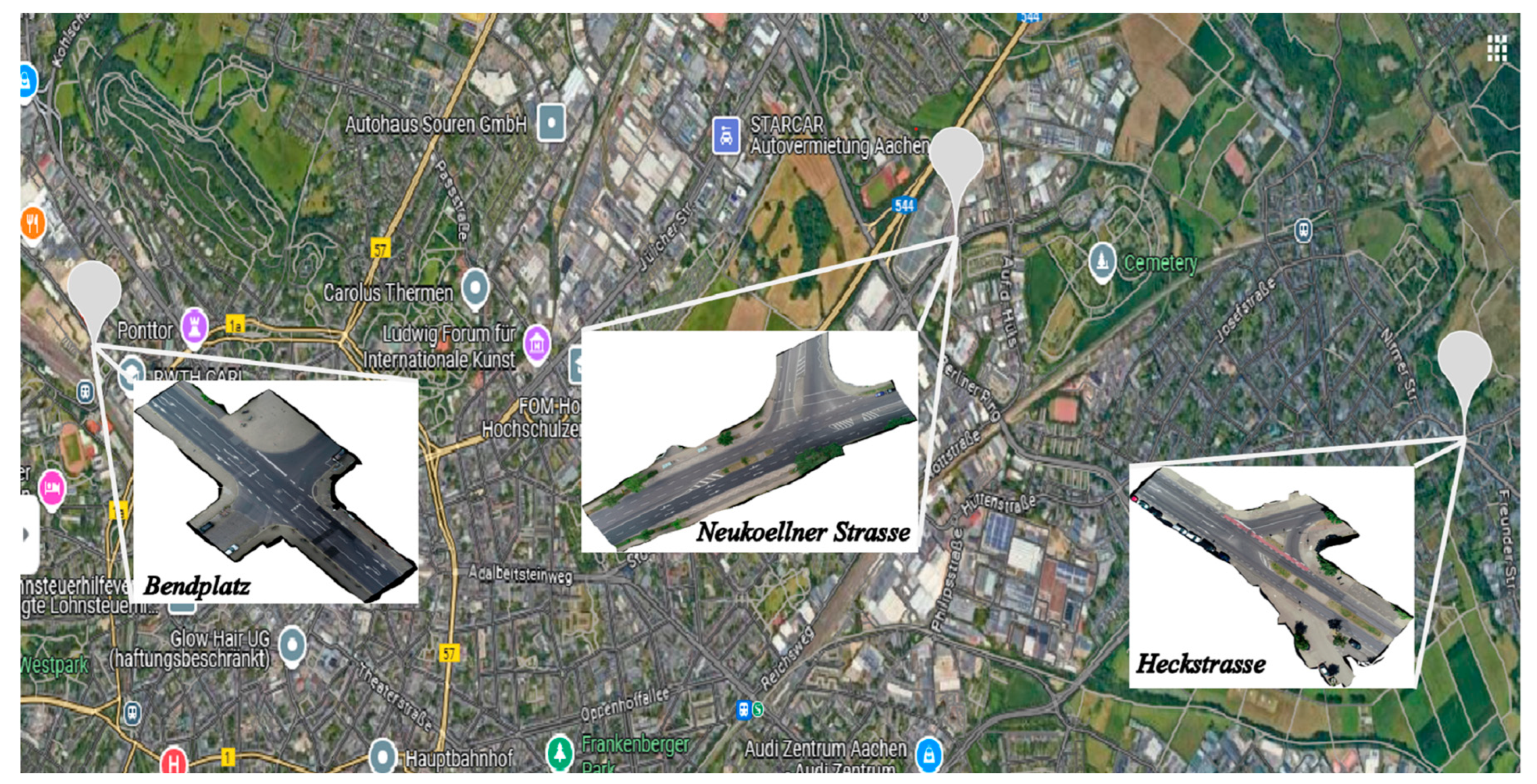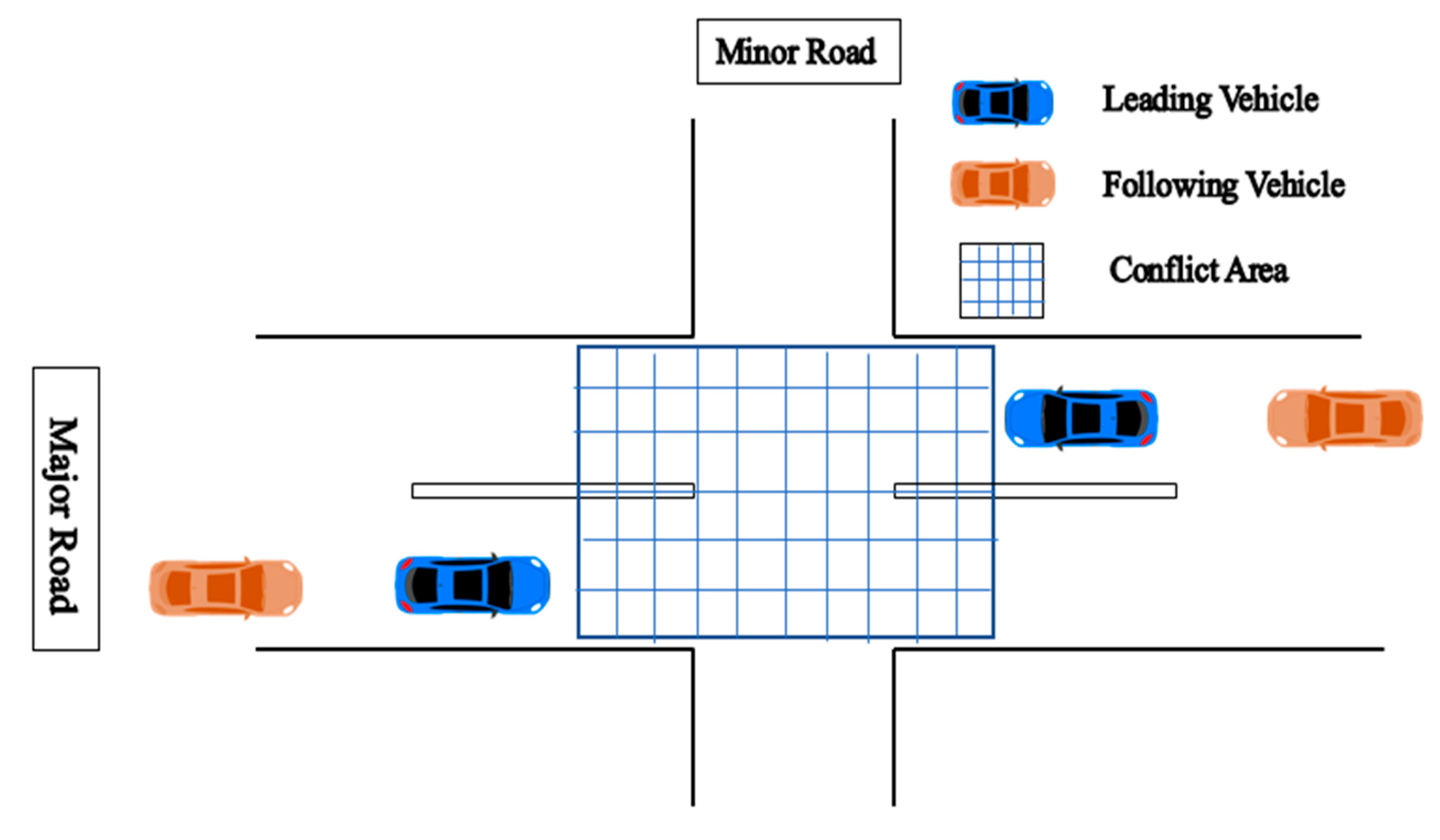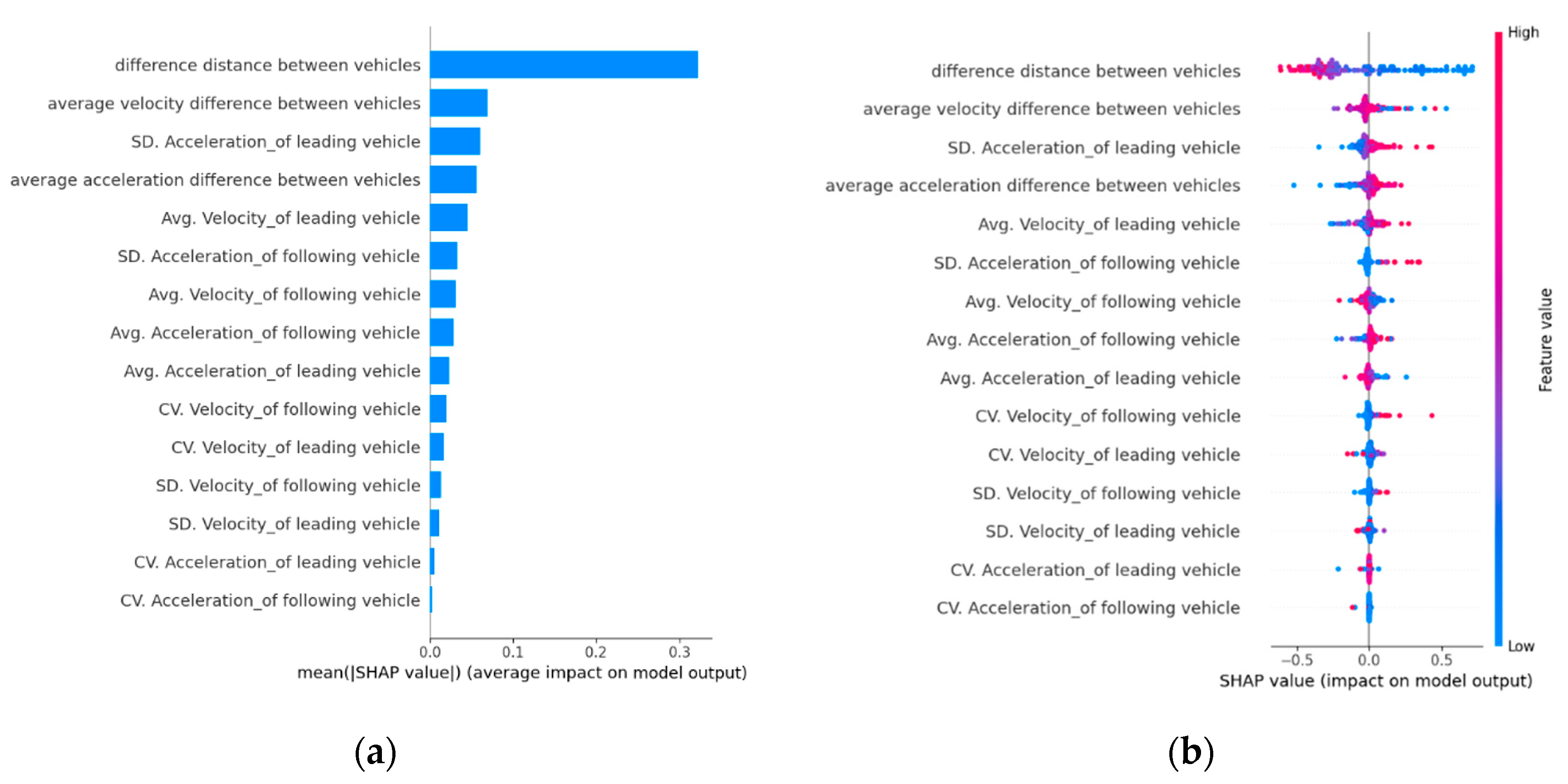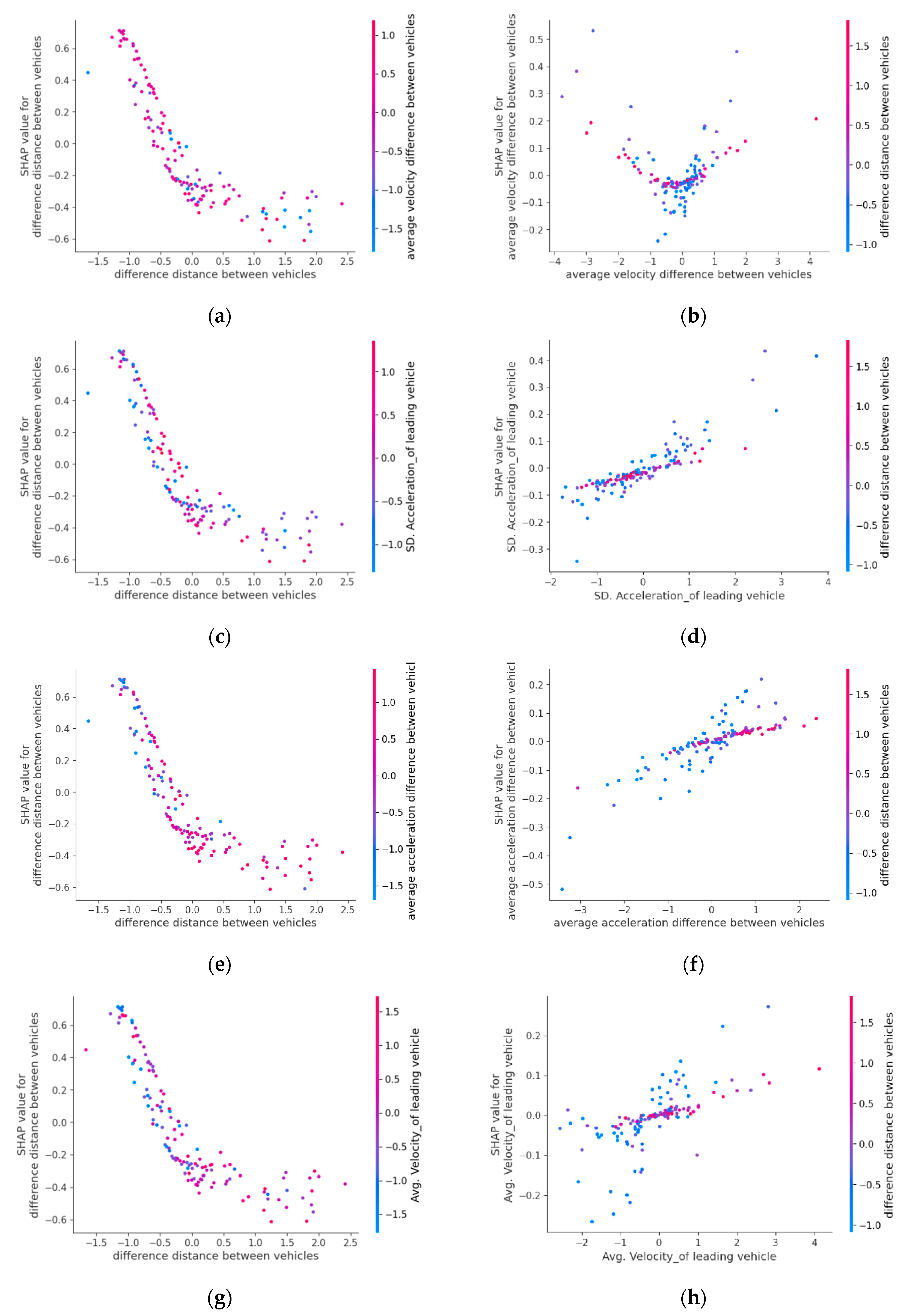Real-Time Risk Identification of Rear-End Conflicts at Unsignalized Intersections
Abstract
1. Introduction
- Proposing an advanced deep learning framework capable of accurate feature extraction and prediction of rear-end traffic conflicts from accurately extracted features at unsignalized intersections.
- Developing a data-driven approach for proactive safety management to improve road safety.
- Employing SHAP (Shapley Additive Explanations) to examine the influence of traffic parameters at lane-level on traffic conflicts at unsignalized intersections in real-time, providing insightful interpretations to city planners and policy makers.
2. Literature Review
2.1. Unsignalized Intersection Safety Research
2.2. Review of Modified Time to Collision
2.3. Modelling Techniques for Risk Prediction (Real-Time Conflict-Based Studies)
3. Methodology
3.1. Data Construction
3.1.1. Trajectory Dataset
3.1.2. Conflict Identification
3.1.3. Traffic Characteristics Extraction
3.2. Interpretable Machine Learning Modeling
3.2.1. Deep Cross Network V2 (DCNv2)
- Cross Network Component
- Deep Network Component
- Combined Output
- Loss Function
3.2.2. SHapley Additive exPlanations (SHAP)
4. Results and Discussion
4.1. Hyperparameter Configuration of DCNv2
4.2. Prediction Performance
- To validate the validity and sophistication of the model, commonly used algorithms were employed to compare the prediction performance.
- LR (Logistic Regression): Logistic Regression is a linear model used for binary classification tasks, predicting the probability of a categorical outcome based on one or more independent variables. Optimal performance is achieved when a near-linear relationship exists between the features and the target variable.
- KNN (K-Nearest Neighbors): K-Nearest Neighbors is a straightforward, instance-based learning algorithm that assigns a class to a data point based on the most common label among its closest neighbors. It is non-parametric and relies on a distance metric, such as Euclidean distance, to measure similarity.
- DT (Decision Tree): A Decision Tree is a tree-structured model used for classification and regression tasks, where decisions are made by splitting the data into subsets based on specific feature values. It creates a model that represents a series of decisions leading to a predicted outcome, making it interpretable and easy to understand.
- SVM (Support Vector Machine): Support Vector Machine is a supervised learning algorithm that finds the optimal hyperplane to separate classes in a high-dimensional space, making it an effective classification for linear and non-linear by using kernel functions to transform input features.
- XGB (Extreme Gradient Boosting): XGBoost is an ensemble learning algorithm that uses gradient boosting to combine multiple weak learners, typically decision trees, into a strong predictive model. It is known for its efficiency, accuracy, and capability to handle large-scale data and complex relationships.
- DNN (Deep Neural Network): Deep Neural Network is an artificial neural network with multiple hidden layers, capable of learning high-level abstractions from data. It is widely used for complex tasks, such as image recognition and natural language processing, due to its ability to model non-linear relationships.
- DCN (Deep Cross Network): Deep Cross Network combines both cross-layer and deep neural network components to learn feature interactions at different levels. It is particularly effective for learning both low-order and high-order feature interactions, making it suitable for complex data environments.
- Accuracy, Recall, and AUC were used as evaluation metrics for predicting outcomes. Accuracy is defined as the fraction of correctly classified instances over all instances in the evaluation set. It is often used to assess a model’s performance across all classes when the dataset has a balanced distribution.
4.3. Models’ Interpretation
4.3.1. Variable Importance
4.3.2. Variables Interactions
5. Conclusions
Author Contributions
Funding
Data Availability Statement
Conflicts of Interest
References
- ETSC. Ranking EU Progress on Road Safety. Brussels, 2023. Available online: https://etsc.eu/ (accessed on 14 April 2025).
- Destatis. Traffic Accidents. 2023. Available online: https://www.destatis.de/ (accessed on 14 April 2025).
- Wisch, M.; Hellmann, A.; Lerner, M.; Hierlinger, T.; Labenski, V.; Wagner, M.; Feifel, H.; Robescu, O.; Renoux, P.; Groult, X. Car-to-car accidents at intersections in Europe and identification of use cases for the test and assessment of respective active vehicle safety systems. In Proceedings of the 26th International Technical Conference on the Enhanced Safety of Vehicles, Eindhoven, The Netherlands, 10–13 June 2019; pp. 10–13. [Google Scholar]
- Das, B.; Paul, M. Development of a Rear-End Conflict Prediction Framework for Unsignalized Intersections along Intercity Highways Using Machine Learning. J. Transp. Eng. Part A Syst. 2025, 151, 4025009. [Google Scholar] [CrossRef]
- Jiang, C.; Lu, L.; Chen, S.; Lu, J.J. Hit-and-run crashes in urban river-crossing road tunnels. Accid. Anal. Prev. 2016, 95, 373–380. [Google Scholar] [CrossRef]
- Hu, Y.; Li, Y.; Yuan, C.; Huang, H. Modeling conflict risk with real-time traffic data for road safety assessment: A copula-based joint approach. Transp. Saf. Environ. 2022, 4, tdac017. [Google Scholar] [CrossRef]
- Xing, L.; He, J.; Abdel-Aty, M.; Wu, Y.; Yuan, J. Time-varying Analysis of Traffic Conflicts at the Upstream Approach of Toll Plaza. Accid. Anal. Prev. 2020, 141, 105539. [Google Scholar] [CrossRef] [PubMed]
- Miglani, A.; Kumar, N. Deep learning models for traffic flow prediction in autonomous vehicles: A review, solutions, and challenges. Veh. Commun. 2019, 20, 100184. [Google Scholar] [CrossRef]
- Zeng, Q.; Huang, H.; Pei, X.; Wong, S.C. Modeling nonlinear relationship between crash frequency by severity and contributing factors by neural networks. Anal. Methods Accid. Res. 2016, 10, 12–25. [Google Scholar] [CrossRef]
- Zheng, L.; Sayed, T. Comparison of Traffic Conflict Indicators for Crash Estimation using Peak Over Threshold Approach. Transp. Res. Rec. 2019, 2673, 493–502. [Google Scholar] [CrossRef]
- Fu, C.; Sayed, T. A multivariate method for evaluating safety from conflict extremes in real time. Anal. Methods Accid. Res. 2022, 36, 100244. [Google Scholar] [CrossRef]
- Arun, A.; Haque, M.M.; Bhaskar, A.; Washington, S.; Sayed, T. A bivariate extreme value model for estimating crash frequency by severity using traffic conflicts. Anal. Methods Accid. Res. 2021, 32, 100180. [Google Scholar] [CrossRef]
- Zheng, L.; Sayed, T.; Essa, M. Validating the bivariate extreme value modeling approach for road safety estimation with different traffic conflict indicators. Accid. Anal. Prev. 2019, 123, 314–323. [Google Scholar] [CrossRef]
- Liu, P.; Qu, X.; Yu, H.; Wang, W.; Cao, B. Development of a VISSIM simulation model for U-turns at unsignalized intersections. J. Transp. Eng. 2012, 138, 1333–1339. [Google Scholar] [CrossRef]
- Caliendo, C.; Guida, M. Microsimulation approach for predicting crashes at unsignalized intersections using traffic conflicts. J. Transp. Eng. 2012, 138, 1453–1467. [Google Scholar] [CrossRef]
- Wu, Z.; Yang, J.; Huang, L. Study on the Collision Avoidance Strategy at Unsignalized Intersection based on PreScan Simulation. Procedia-Soc. Behav. Sci. 2013, 96, 1315–1321. [Google Scholar] [CrossRef]
- Yuan, C.; Li, Y.; Huang, H.; Wang, S.; Sun, Z.; Li, Y. Using traffic flow characteristics to predict real-time conflict risk: A novel method for trajectory data analysis. Anal. Methods Accid. Res. 2022, 35, 100217. [Google Scholar] [CrossRef]
- Li, J.; Ling, M.; Zang, X.; Luo, Q.; Yang, J.; Chen, S.; Guo, X. Quantifying risks of lane-changing behavior in highways with vehicle trajectory data under different driving environments. Int. J. Mod. Phys. C 2024, 35, 2450141. [Google Scholar] [CrossRef]
- Ding, N.; Jiao, N.; Zhu, S.; Liu, B. Structural equations modeling of real-time crash risk variation in car-following incorporating visual perceptual, vehicular, and roadway factors. Accid. Anal. Prev. 2019, 133, 105298. [Google Scholar] [CrossRef]
- Li, Y.; Wu, D.; Lee, J.; Yang, M.; Shi, Y. Analysis of the transition condition of rear-end collisions using time-to-collision index and vehicle trajectory data. Accid. Anal. Prev. 2020, 144, 105676. [Google Scholar] [CrossRef]
- Li, Y.; Wu, D.; Chen, Q.; Lee, J.; Long, K. Exploring transition durations of rear-end collisions based on vehicle trajectory data: A survival modeling approach. Accid. Anal. Prev. 2021, 159, 106271. [Google Scholar] [CrossRef] [PubMed]
- Chen, Q.; Huang, H.; Li, Y.; Lee, J.; Long, K.; Gu, R.; Zhai, X. Modeling accident risks in different lane-changing behavioral patterns. Anal. Methods Accid. Res. 2021, 30, 100159. [Google Scholar] [CrossRef]
- Chen, S.; Piao, L.; Zang, X.; Luo, Q.; Li, J.; Yang, J.; Rong, J. Analyzing differences of highway lane-changing behavior using vehicle trajectory data. Phys. A Stat. Mech. Its Appl. 2023, 624, 128980. [Google Scholar] [CrossRef]
- Zhai, C.; Wu, W.; Xiao, Y.; Zhang, J.; Zhai, M. Jam traffic pattern of a multi-phase lattice hydrodynamic model integrating a continuous self-stabilizing control protocol to boycott the malicious cyber-attacks. Chaos Solitons Fractals 2025, 197, 116531. [Google Scholar] [CrossRef]
- Gore, N.; Chauhan, R.; Easa, S.; Arkatkar, S. Traffic conflict assessment using macroscopic traffic flow variables: A novel framework for real-time applications. Accid. Anal. Prev. 2023, 185, 107020. [Google Scholar] [CrossRef]
- Arun, A.; Haque, M.M.; Washington, S.; Sayed, T.; Mannering, F. How many are enough?: Investigating the effectiveness of multiple conflict indicators for crash frequency-by-severity estimation by automated traffic conflict analysis. Transp. Res. Part C Emerg. Technol. 2022, 138, 103653. [Google Scholar] [CrossRef]
- Jiang, R.; Zhu, S.; Chang, H.; Wu, J.; Ding, N.; Liu, B.; Qiu, J. Determining an Improved Traffic Conflict Indicator for Highway Safety Estimation Based on Vehicle Trajectory Data. Sustainability 2021, 13, 9278. [Google Scholar] [CrossRef]
- Hayward, J.C. Near-miss determination through use of a scale of danger. Highw. Res. Rec. 1972, 384, 24–35. [Google Scholar]
- Jiao, S.; Zhang, S.; Zhou, B.; Zhang, L.; Xue, L. Dynamic performance and safety analysis of car-following models considering collision sensitivity. Phys. A Stat. Mech. Its Appl. 2021, 564, 125504. [Google Scholar] [CrossRef]
- Das, S.; Maurya, A.K. Defining Time-to-Collision Thresholds by the Type of Lead Vehicle in Non-Lane-Based Traffic Environments. IEEE Trans. Intell. Transp. Syst. 2020, 21, 4972–4982. [Google Scholar] [CrossRef]
- Xiao, Y.; Wu, W.; Zhai, C.; Zhai, M.; Zhang, J. Analysis of empirical lane-changing rate effect on multi-lane traffic on curved roads. Chin. J. Phys. 2025, 95, 260–274. [Google Scholar] [CrossRef]
- Ozbay, K.; Yang, H.; Bartin, B.; Mudigonda, S. Derivation and validation of new simulation-based surrogate safety measure. Transp. Res. Rec. 2008, 2083, 105–113. [Google Scholar] [CrossRef]
- Arun, A.; Haque, M.M.; Washington, S.; Sayed, T.; Mannering, F. A systematic review of traffic conflict-based safety measures with a focus on application context. Anal. Methods Accid. Res. 2021, 32, 100185. [Google Scholar] [CrossRef]
- Chen, Z.; Chen, W. Traffic Safety Analysis of a Signalized T-Intersection Using Surrogate Safety Measures. In Proceedings of the 24th COTA International Conference of Transportation Professionals, Shenzhen, China, 23–26 July 2024; pp. 2613–2623. [Google Scholar]
- Jiang, C.; Yin, S.; Yao, Z.; He, J.; Jiang, R.; Jiang, Y. Safety evaluation of mixed traffic flow with truck platoons equipped with (cooperative) adaptive cruise control, stochastic human-driven cars and trucks on port freeways. Phys. A Stat. Mech. Its Appl. 2024, 643, 129802. [Google Scholar] [CrossRef]
- Zhu, L.; Lu, L.; Wang, X.; Jiang, C.; Ye, N. Operational Characteristics of Mixed-Autonomy Traffic Flow on the Freeway With On-and Off-Ramps and Weaving Sections: An RL-Based Approach. IEEE Trans. Intell. Transp. Syst. 2022, 23, 13512–13525. [Google Scholar] [CrossRef]
- Jiang, C.; Bhat, C.R.; Lam, W.H.K. A bibliometric overview of Transportation Research Part B: Methodological in the past forty years (1979–2019). Transp. Res. Part B Methodol. 2020, 138, 268–291. [Google Scholar] [CrossRef]
- Wu, P.; Wei, W.; Zheng, L.; Hu, Z.; Essa, M. Cycle-level traffic conflict prediction at signalized intersections with LiDAR data and Bayesian deep learning. Accid. Anal. Prev. 2023, 192, 107268. [Google Scholar] [CrossRef]
- Hou, Q.; Yang, Y.; Liang, J.; Huo, X.; Leng, J. A deep transfer learning approach for Real-Time traffic conflict prediction with trajectory data. Accid. Anal. Prev. 2025, 214, 107966. [Google Scholar] [CrossRef]
- Zhang, S.; Abdel-Aty, M. Real-Time Pedestrian Conflict Prediction Model at the Signal Cycle Level Using Machine Learning Models. IEEE Open J. Intell. Transp. Syst. 2022, 3, 176–186. [Google Scholar] [CrossRef]
- Formosa, N.; Quddus, M.; Ison, S.; Abdel-Aty, M.; Yuan, J. Predicting real-time traffic conflicts using deep learning. Accid. Anal. Prev. 2020, 136, 105429. [Google Scholar] [CrossRef] [PubMed]
- Yu, R.; Han, L.; Zhang, H. Trajectory data based freeway high-risk events prediction and its influencing factors analyses. Accid. Anal. Prev. 2021, 154, 106085. [Google Scholar] [CrossRef]
- Katrakazas, C.; Quddus, M.; Chen, W.H. A simulation study of predicting real-time conflict-prone traffic conditions. IEEE Trans. Intell. Transp. Syst. 2018, 19, 3196–3207. [Google Scholar] [CrossRef]
- Caleffi, F.; Anzanello, M.J.; Cybis, H.B.B. A multivariate-based conflict prediction model for a Brazilian freeway. Accid. Anal. Prev. 2017, 98, 295–302. [Google Scholar] [CrossRef] [PubMed]
- Li, Y.; Ge, C.; Xing, L.; Yuan, C.; Liu, F.; Jin, J. A hybrid deep learning framework for conflict prediction of diverse merge scenarios at roundabouts. Eng. Appl. Artif. Intell. 2024, 130, 107705. [Google Scholar] [CrossRef]
- Bock, J.; Krajewski, R.; Moers, T.; Runde, S.; Vater, L.; Eckstein, L. The inD Dataset: A Drone Dataset of Naturalistic Road User Trajectories at German Intersections. In Proceedings of the 2020 IEEE Intelligent Vehicles Symposium (IV), Las Vegas, NV, USA, 19 October–13 November 2020; pp. 1929–1934. [Google Scholar] [CrossRef]
- Ronneberger, O.; Fischer, P.; Brox, T. U-Net: Convolutional Networks for Biomedical Image Segmentation. May 2015. Available online: http://arxiv.org/abs/1505.04597 (accessed on 14 April 2025).
- Rauch, H.E.; Tung, F.; Striebel, C.T. Maximum likelihood estimates of linear dynamic systems. AIAA J. 1965, 3, 1445–1450. [Google Scholar] [CrossRef]
- Amundsen, F.; Hydén, C. Proceedings of the first workshop on traffic conflicts: (Held September 1977 in Oslo.) Institute of Transfort Economics, Oslo, Norway, 1977; 138pp. Accid. Anal. Prev. 1979, 11, 317–318. [Google Scholar]
- Orsini, F.; Gecchele, G.; Rossi, R.; Gastaldi, M. A conflict-based approach for real-time road safety analysis: Comparative evaluation with crash-based models. Accid. Anal. Prev. 2021, 161, 106382. [Google Scholar] [CrossRef]
- Nasr, H.A.; Huang, H.; Jin, J.; Zhou, H. Rear-end conflicts analysis at non-signalized intersection based on vehicles trajectory data. Eur. Transp. Res. Rev. 2025, 17, 27. [Google Scholar] [CrossRef]
- Arun, A.; Haque, M.M.; Bhaskar, A.; Washington, S.; Sayed, T. A systematic mapping review of surrogate safety assessment using traffic conflict techniques. Accid. Anal. Prev. 2021, 153, 106016. [Google Scholar] [CrossRef] [PubMed]
- Jin, J.; Huang, H.; Yuan, C.; Li, Y.; Zou, G.; Xue, H. Real-time crash risk prediction in freeway tunnels considering features interaction and unobserved heterogeneity: A two-stage deep learning modeling framework. Anal. Methods Accid. Res. 2023, 40, 100306. [Google Scholar] [CrossRef]
- Zhang, G.; Jin, J.; Chang, F.; Huang, H. Real-time traffic conflict prediction at signalized intersections using vehicle trajectory data and deep learning. Int. J. Transp. Sci. Technol. 2024, in press. [CrossRef]
- Jin, J.; Huang, H.; Li, Y.; Dai, J. Collision causal discovery and real-time prediction of freeway tunnels: A novel dual-task approach. Tunn. Undergr. Sp. Technol. 2025, 155, 106216. [Google Scholar] [CrossRef]





| Variables | Mean | Std. Dev | Min. | Max. | |
|---|---|---|---|---|---|
| F1: | Average velocity of leading vehicle (m/s) | 12.65 | 2.68 | 3.71 | 23.66 |
| F2: | Average velocity of following vehicle (m/s) | 12.37 | 2.70 | 1.15 | 20.82 |
| F3: | Average acceleration of leading vehicle (m/s2) | 0.31 | 0.45 | −1.98 | 2.53 |
| F4: | Average acceleration of following vehicle (m/s2) | 1.54 | 0.56 | −0.77 | 3.96 |
| F5: | Standard deviation in the average velocity of leading vehicle (m/s) | 0.36 | 0.34 | 0.10 | 2.54 |
| F6: | Standard deviation in the average velocity of following vehicle (m/s) | 0.12 | 0.17 | 0.00 | 1.80 |
| F7: | Standard deviation in the average acceleration of leading vehicle (m/s2) | 0.59 | 0.18 | 0.17 | 2.07 |
| F8: | Standard deviation in the average acceleration of following vehicle (m/s2) | 0.05 | 0.13 | 0.00 | 1.04 |
| F9: | Coefficient of variation in the average velocity of leading vehicle (m/s) | 0.03 | 0.04 | 0.01 | 0.53 |
| F10: | Coefficient of variation in the average velocity of following vehicle (m/s) | 0.01 | 0.02 | 0.00 | 0.22 |
| F11: | Coefficient of variation in the average acceleration of leading vehicle (m/s2) | 1.26 | 11.52 | −9.36 | 18.85 |
| F12: | Coefficient of variation in the average acceleration of following vehicle (m/s2) | 0.21 | 4.13 | −2.83 | 4.14 |
| F13: | Difference in average acceleration between leading and following vehicles (m/s2) | 1.23 | 0.53 | −0.84 | 3.89 |
| F14: | Difference in average velocity between leading and following vehicles (m/s) | 0.28 | 1.49 | −8.73 | 14.88 |
| F15: | Gap difference between leading and following vehicles (m) | 24.21 | 13.92 | 0.50 | 113.16 |
| Hyperparameter Network Structure | Value |
|---|---|
| Cross Layers | 4 |
| Deep Layers | 4 |
| Neurons per Deep Layer | [256, 128, 64, 32] |
| Activation (Deep) | ReLU |
| Activation (Cross) | Linear |
| Optimization | |
| Loss Function | Binary Cross-Entropy |
| Optimizer | Adam |
| Learning Rate | 0.001 (decay: 0.96 per 10 epochs) |
| Training | |
| Batch Size | 64 |
| Epochs | 100 |
| L2 Regularization | 0.0001 |
| Dropout Rate | 0.3 |
| True Condition | Prediction Result | |
|---|---|---|
| Crash | No Crash | |
| Crash | True Positive (TP) | False Negative (FN) |
| No Crash | False Positive (FP) | True Negative (TN) |
| Methods | Accuracy | Recall | AUC | Precision | F1-Score |
|---|---|---|---|---|---|
| LR | 0.88 | 0.83 | 0.87 | 0.86 | 0.84 |
| KNN | 0.81 | 0.71 | 0.78 | 0.77 | 0.74 |
| DT | 0.82 | 0.75 | 0.80 | 0.78 | 0.76 |
| SVM | 0.91 | 0.87 | 0.90 | 0.89 | 0.88 |
| XGB | 0.90 | 0.89 | 0.87 | 0.86 | 0.87 |
| DNN | 0.89 | 0.88 | 0.87 | 0.85 | 0.86 |
| DCN | 0.92 | 0.90 | 0.91 | 0.88 | 0.89 |
| DCNV2 | 0.93 | 0.90 | 0.92 | 0.90 | 0.90 |
Disclaimer/Publisher’s Note: The statements, opinions and data contained in all publications are solely those of the individual author(s) and contributor(s) and not of MDPI and/or the editor(s). MDPI and/or the editor(s) disclaim responsibility for any injury to people or property resulting from any ideas, methods, instructions or products referred to in the content. |
© 2025 by the authors. Licensee MDPI, Basel, Switzerland. This article is an open access article distributed under the terms and conditions of the Creative Commons Attribution (CC BY) license (https://creativecommons.org/licenses/by/4.0/).
Share and Cite
Nasr, H.A.; Jin, J.; Huang, H.; Eljailany, H.A. Real-Time Risk Identification of Rear-End Conflicts at Unsignalized Intersections. Systems 2025, 13, 827. https://doi.org/10.3390/systems13090827
Nasr HA, Jin J, Huang H, Eljailany HA. Real-Time Risk Identification of Rear-End Conflicts at Unsignalized Intersections. Systems. 2025; 13(9):827. https://doi.org/10.3390/systems13090827
Chicago/Turabian StyleNasr, Hussain A., Jieling Jin, Helai Huang, and Hala A. Eljailany. 2025. "Real-Time Risk Identification of Rear-End Conflicts at Unsignalized Intersections" Systems 13, no. 9: 827. https://doi.org/10.3390/systems13090827
APA StyleNasr, H. A., Jin, J., Huang, H., & Eljailany, H. A. (2025). Real-Time Risk Identification of Rear-End Conflicts at Unsignalized Intersections. Systems, 13(9), 827. https://doi.org/10.3390/systems13090827







